2. 江西师范大学,鄱阳湖湿地与流域研究教育部重点实验室,南昌 330022
塑料工业的发展在给人类社会生产、生活带来方便的同时,大量的废旧塑料垃圾也不断产生,且从不同的途径进入环境[1]。据科学家推测,每个塑料制品可能会在环境中留存长达400~1 000 a,因此,自从20世纪50年代以来人类生产的每件塑料制品依然会残留在地球环境中,并扩散到人类活动的各个领域[2]。塑料污染已经成为一个日益严重的环境问题,其对全球各国环境和经济造成了严重威胁[3]。相比于塑料,微塑料(粒径 < 5 mm的塑料)更值得关注,微塑料是一种新型的污染物,其所引起的环境问题已成为近年来的研究热点[4]。环境中微塑料由于颗粒小、具有疏水性等特征,是持久性有机污染物等有毒有害化学物质的载体,并可通过洋流作用迁移扩散,影响污染物的全球分布,且易于被海洋鱼、贝类等生物体摄食,从而构成严重的生态风险[5-6]。目前,国内外开展了大量的关于微塑料的研究,然而其大多数侧重于海洋环境[7]。尽管淡水和陆地环境被认为是海洋塑料的来源和运输路径,但是关于这些环境区域的研究仍然比较缺乏[8-9]。关于中国内陆湖泊微塑料的研究亦是不足的[10]。
鄱阳湖是中国的第一大淡水湖,也是我国公布的首批国家重点湿地保护地之一[11]。鄱阳湖在维护长江中下游水生生物多样性,实现水生生物种质资源的可持续利用方面起着十分重要的作用[12]。鄱阳湖受长江倒灌水和流域来水的影响,形成了独特的生态水文过程,湖区丰枯水位变化大,丰水季节出现在5-9月,枯水季节出现于12-2月,年水位变幅8~14 m[13]。近年来,受江湖关系变化影响以及流域降水等多种因素的合力综合作用,鄱阳湖水位变化较大,从而使沉积物出露时间提前并延长,增加了污染物释放的风险[14]。目前国内外学者对鄱阳湖生态安全的研究越来越重视,已有一定的研究基础,但是关于微塑料的污染研究还很缺乏。
本研究选择鄱阳湖-赣江各分支入湖段为研究区(由于赣江流经了江西省人口最密集的南昌市全区,可能是受微塑料污染最严重的典型区域),并选择南矶山湿地国家级自然保护区作为对照区,以湖泊湿地沉积物为研究对象,采集不同时期的沉积物样品,通过浮选分离法分离其中的微塑料,并利用显微镜和红外光谱结合来鉴定微塑料,进而研究鄱阳湖微塑料的分布和组成特征,进一步探讨其微塑料来源,以期了解鄱阳湖-赣江各支入湖段微塑料的污染现状。研究结果有助于制定塑料垃圾管理政策,并为湖泊微塑料污染的预警模式、提高湖泊环境管理提供理论依据。
1 材料与方法 1.1 研究区概况鄱阳湖位于北纬28°22′-29°45′,东经115°47′-116°45′,地处江西省的北部,长江中下游南岸。汇集赣江、修水、鄱江、饶河、信江、抚河等水经九江市湖口县城注入长江[15]。本研究选取鄱阳湖-赣江各支入湖段作为研究区,并以将南矶山国家级自然保护区作为研究对照区,分别在赣江北支、中支、南支以及南矶湿地国家级自然保护区布设采样点,每个区域3个样点,每个样点相隔3 km,共计12个采样点(图 1),每个样点有3个重复。调查每个样点的位置、盐度、平均温度等信息。选择在枯水期(11-12月)、平水期(3-4月)和丰水期(7-8月)三个典型水期进行沉积物采样[16]。
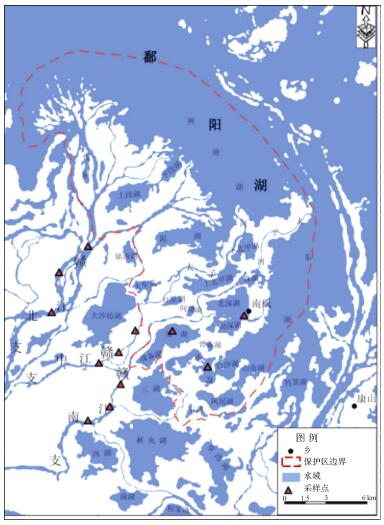
|
图 1 采样点分布图 Fig. 1 Distribution of sampling sites |
2016年12月(枯水期),在南矶山国家级自然保护区以及赣江各支流入湖口采集沉积物样品。每个采样点设置3个50 cm × 50 cm的小样方,用铲子收集表层2 cm的湖岸沉积物,每个样方相隔50 m。沉积物样品收集后被保存在采样袋中,尽快运回实验室,然后风干,干燥后保存于白色托盘中中以待分析,在此过程中应尽量避免污染。2017年4月(平水期)和2017年8月(丰水期)又分别进行了沉积物样品采集。
利用密度浮选分离法进行沉积物中微塑料的分离[17]。具体步骤:称取1 kg土壤样品(干重)分别经过1 mm和2 mm筛,1~2 mm和>2 mm的材料保存在筛内用肉眼进行微塑料的检查。过筛的样品(< 1 mm)被转移至分离装置中进行密度分离,先用饱和氯化钠溶液浮选,获得初步分离样品,然后再用饱和氯化钠溶液进行进一步的浮选分离,收集上清液,静置后用真空抽滤装置(GM-0.33A)抽滤,收集抽滤后的滤膜(孔径5 μm),保留滤膜于玻璃皿中以待下一步分析。将浮选分离得到的滤膜置于金相显微镜(上海精密仪器公司)下,计数,测量微塑料的粒径,并观察各类微塑料外观及形态等特征。利用红外光谱仪(Nicolet 6700)来检测微塑料的组成成分,并结合扫描电子显微镜(S-3400N,SEM,日本日立电子)对微塑料表面的微观特性进行表征及分类。
1.3 数据处理底泥沉积物中微塑料丰度使用“ind·kg-1(干重沉积物)”单位表示。采用SPASS19.0单因素方差分析(One Way ANOVA)进行不同水期和不同采样区域微塑料丰度的差异显著性检验,显著性水平设定为α=0.05,并利用一般线性模型(General Linear Models)进行不同区域和不同时期的双因素方差分析。相关图表制作在Excel2010中完成。
2 结果 2.1 沉积物样品中微塑料时空分布特征如图 2所示,四个不同区域沉积物样品中微塑料丰度差异很大,其中赣江中支微塑料丰度最高,达到1 936±89 ind·kg-1,赣江北支的微塑料丰度最低,仅11±6 ind·kg-1,赣江中支和南支微塑料丰度显著高于南矶山和赣江北支(P < 0.05)。
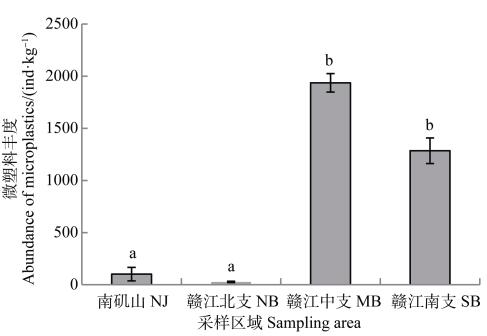
|
注:图中小写字母不同表示不同区域差异显著(P < 0.05)。 Note:Different letters indicate significant difference at 0.05 level. NJ:Nanjishan; NB:the northern branch of Ganjiang River; MB:the mid branch of Ganjiang River; SB:the southern branch of Ganjiang River. 图 2 研究区沉积物样品中微塑料丰度 Fig. 2 Abundance of microplastics in the sediment relative to sampling site |
南矶山和赣江北支不同水期沉积物中微塑料丰度没有显著性差异(P>0.05),且均保持在较低的丰度水平。赣江中支不同水期沉积物中微塑料丰度差异显著(P < 0.05),赣江南支不同水期沉积物中微塑料表现为枯水期高于平水期高于丰水期,但未达到显著(表 1)。
|
|
表 1 不同区域不同水期微塑料丰度 Table 1 Abundance of microplastics in Nanji and the middle branch of the Ganjiang River relative to water season |
如表 2所示,采样区域和采样时间均对微塑料丰度有显著影响,其交互作用也达到了显著(P < 0.05)。
|
|
表 2 采样区域和采样时间对微塑料丰度影响的两因素方差分析 Table 2 Two-factor variance analysis of effects of area and timing of sampling on microplastics abunance |
不同区域沉积物样品中微塑料类型组成各不相同。如图 3所示,南矶山沉积物中微塑料以发泡类为主,其次为纤维类、薄膜类,未发现碎片类微塑料。赣江各支沉积物中微塑料主要由碎片类、薄膜类、发泡类和纤维类4种类型组成。其中赣江北支沉积物中微塑料以纤维类为主,其次为发泡类。赣江中支和南支沉积物中微塑料以碎片类为主,占微塑料总量的50%以上。
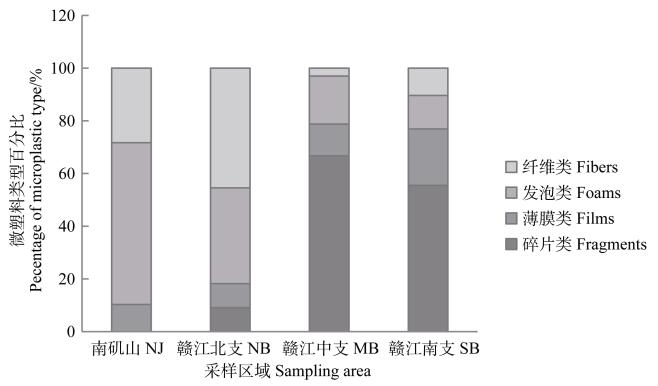
|
图 3 研究区沉积物样品中微塑料类型百分比 Fig. 3 Composition of the microplastics in the sediment and proportions of the components relative to study areas |
南矶山沉积物中微塑料粒径以2~3 mm为主,其次为3~4 mm,未发现 < 1 mm微塑料。赣江各大支流沉积物中微塑料以 < 1 mm为主,占微塑料总数的60%以上,微塑料丰度高低顺序均为 < 1 mm、1~2 mm、2~3 mm、3~4 mm、4~5 mm,基本随着粒径的增大所占比例减小(图 4)。

|
图 4 研究区沉积物样品中微塑料粒径百分比 Fig. 4 Particle size composition of the microplastics in the sediment relative to study areas |
扫描电子显微镜图显示,不同类型微塑料表面形貌特征各不相同,其表面粗糙度也相差很大(图 5)。其中,薄膜类微塑料表面光滑柔软且不规则(a)。纤维类微塑料表面光滑,线形,颜色多为蓝色(b)。发泡类微塑料多为白色,质地轻,形状各异(c),碎片类微塑料颜色和形态多样,表面粗糙不平,并有明显的磨损痕迹(d)。
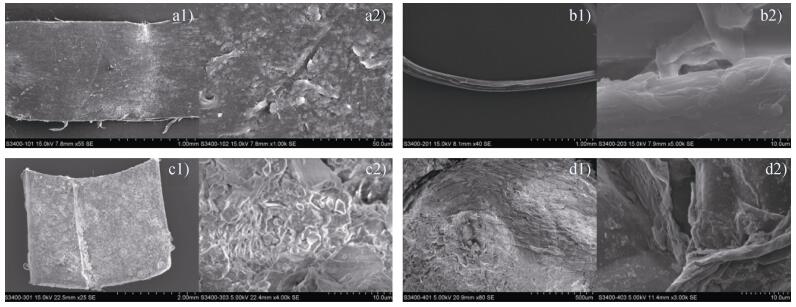
|
a.薄膜类Films; b.纤维类Fibers; c.发泡类Foams; d.碎片类Fragments. 图 5 不同类型微塑料表面形貌SEM图 Fig. 5 Scanning electron micrographs(SEM)of surface of the microplastics relative to type |
如图 6所示,不同类型微塑料红外光谱图也各不相同,其组成成分也相差较大。硬质塑料碎片类组成成分为聚乙烯(a); 编织袋碎片类组成成分为聚丙烯(b); 发泡类组成成分为聚苯乙烯(c); 红色塑料袋薄膜类其主要组成成分为聚丙烯(d),白色塑料袋薄膜类其主要成分为聚丙烯(e),纤维类微塑料,选取的是渔线,其组成成分为聚乙烯(f)(图 7)。可以看出,硬质塑料碎片类和纤维类微塑料组成成分相同,均为聚乙烯; 编织袋碎片类以及红色塑料袋、白色塑料袋薄膜类微塑料组成成分均为聚丙烯,发泡类组成成分为聚苯乙烯。
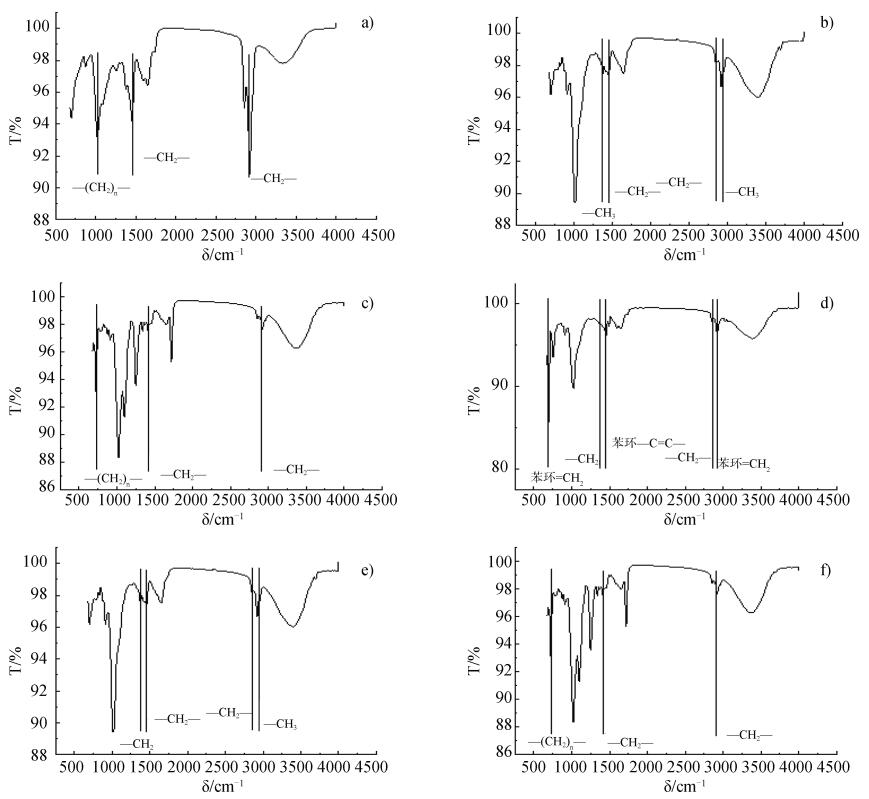
|
a)硬质碎片类Solid fragements; b)编织袋碎片类Fragements of woven bag; c)发泡类Foams; d)红色塑料袋薄膜Red plastic films; e)白色塑料袋薄膜White plastic films; f)纤维类Fibres. 图 6 不同种类微塑料的红外光谱图 Fig. 6 FTIR spectrum of the microplastics relative to type |
微塑料在环境中无处不在,是当今不可忽视的新型污染物[5]。近年来,在越来越多的区域检测到了微塑料的存在,包括极地和偏远地区[9, 18]。不同区域微塑料丰度差异较大。例如,伊朗主要的石油出口枢纽哈克岛沿岸沉积物中微塑料丰度从295至1 085 ind·kg-1[19]。英国泰晤士河流域沉积物中微塑料最高位平均为660 ind·kg-1[20]。周倩等[21]的研究结果表明,滨海潮滩土壤微塑料丰度达634 ind·kg-1。香港沿岸地区沉积物中微塑料平均浓度49~279 ind·kg-1[22]。太湖沉积物中微塑料丰度为11.0~234.6 ind·kg-1[8]。渤海、黄海北部和黄海南部沉积物中微塑料平均丰度分别为171.8、123.6和72.0 ind·kg-1[23]。长江河口湾沉积物微塑料丰度为121±9 ind·kg-1[24]。俄罗斯波罗的海沉积物样本中微塑料平均浓度为34±10 ind·kg-1[25]。鄱阳湖-赣江各支入湖段枯水期沉积物样品中微塑料丰度为11~1 936 ind·kg-1,高于上述大部分研究区,可见鄱阳湖-赣江各支入湖段微塑料污染整体处于中等偏上水平。本研究表明赣江中支不同水期微塑料丰度为枯水期高于平水期高于丰水期,丰水期微塑料浓度显著降低可能是由于水对微塑料的稀释作用。
不同区域微塑料类型和粒径也各不相同。赣江各支沉积物中微塑料主要由碎片类、薄膜类、发泡类和纤维类组成,且以碎片类为主。伊朗主要的石油出口枢纽哈克岛沿岸沉积物中微塑料主要是碎片和纤维[19]。英国泰晤士河流域沉积物中微塑料91%是碎片[20]。滨海潮滩土壤微塑料以颗粒类微塑料丰度最大[21]。太湖沉积物中微塑料以纤维类为主[8]。渤海、黄海北部和黄海南部沉积物中微塑料以纤维类为主[23]。长江河口湾沉积物微塑料以纤维为主要类型[24]。太湖、渤海、黄海和长江河口湾沉积物中微塑料均以 < 1 mm为主[8, 23-24],本研究与上述研究结果相符。< 1 mm的微塑料可能更容易被生物摄入,对生物的威胁也可能更大,并对生物体具有广泛的影响,未来研究将会重点关注这部分微塑料。
3.2 微塑料来源分析微塑料来源的研究有助于制定海滩微塑料垃圾管理政策,有效地创建长期的措施来减少污染物的流入[26]。有研究表明,湖泊微塑料丰度在不同空间显著不同,并与到市中心的距离呈负相关,这证实了人为因素在微塑料分布中的重要作用[27]。本研究亦表明微塑料丰度与人类活动密切相关,研究区中南矶山和赣江北支入湖口吴城均为国家级自然保护区,其人类活动相对较少,所以微塑料丰度很小。而赣江中支和南支入湖段人类活动较多,所以微塑料丰度也较大,是受微塑料污染最严重的典型区域。微塑料的来源包括初级来源和二次来源,初级来源是用于化妆品和清洁剂中的微珠以及源于洗衣服的纤维碎片,二次来源例如塑料垃圾和碎片的分解[10]。
本研究表明,赣江各支入湖段沉积物中微塑料主要有碎片类、发泡类、薄膜类和纤维类,其中以碎片类微塑料为主。经现场调查和查阅相关文献,研究区内的碎片类微塑料主要包括硬质塑料碎片类和编织袋碎片类,碎片类微塑料颜色和形态多样,表面粗糙不平,并有明显的磨损痕迹,硬质塑料碎片类组成成分为聚乙烯,编织袋碎片类组成成分为聚丙烯。因此推测其主要来源于一些生活中常用的塑料制品以及化肥和水泥等包装袋的分解[28],塑料制品比如塑料瓶,实际调查中发现在湖岸边有很多丢弃的塑料瓶,其持续分解会产生微塑料碎片。纤维类微塑料表面光滑,线形,颜色多为蓝色,纤维类微塑料组成成分为聚乙烯; 可判断其主要来源于养殖网、鱼网和鱼线碎裂。此外,生活污水中的纤维碎片也是纤维类微塑料的一部分来源,其随排水系统进入污水处理厂但不易被截获而排入水体中[29],由于赣江流经了江西省人口最密集的南昌市全区,所以也会将生活污水中的微塑料带入鄱阳湖。薄膜类微塑料包括红色塑料袋和白色塑料袋薄膜类,其表面光滑柔软且不规则,组成成分均为聚丙烯,可推测主要来源于渔民日常生活中所使用的膜类食品包装袋和鱼饲料编织袋上的防水薄膜层[30]。发泡类微塑料多为白色、质地轻、形状各异,组成成分为聚苯乙烯,推测其主要来源于废弃的泡沫包装箱、一次性泡沫餐具以及渔民所用的发泡浮子。
4 结论在选定的鄱阳湖-赣江各支流四个研究区内,沉积物中微塑料丰度由高到低依次为赣江中支、赣江南支、南矶山、赣江北支,其值分别为1 452± 221 ind·kg-1、1 285±69、102±65 ind·kg-1、11± 6 ind·kg-1。赣江中支不同水期沉积物中微塑料丰度差异显著(P < 0.05),表现为枯水期高于平水期高于丰水期。不同区域沉积物样品中微塑料类型各不相同,南矶山沉积物中微塑料以发泡类为主,其次为纤维类。赣江各支流沉积物中微塑料主要由碎片类、薄膜类、发泡类和纤维类组成。赣江北支沉积物中微塑料以纤维类为主,赣江中支和赣江南支沉积物中微塑料以碎片类为主,占微塑料总量的一半以上。南矶山沉积物中微塑料粒径以2~3mm为主,其次是3~4mm。赣江各大支流沉积物中微塑料以 < 1 mm为主,占到了总数的1/2以上,微塑料丰度高低顺序均为 < 1 mm、1~2 mm、2~3 mm、3~4 mm、4~5 mm,随着粒径的增大所占比例减小。不同类型微塑料表面形貌特征不同,表面粗糙度也相差很大。鄱阳湖-赣江各支入湖段微塑料主要由聚乙烯和聚丙烯组成。微塑料与人类活动密切相关,研究区微塑料主要来自于日常塑料用品的分解以及化肥和水泥等包装袋的分解。
| [1] |
Colton J B, Burns B R, Knapp F D. Plastic particles in surface waters of the northwestern Atlantic . Science, 1974, 185(4150): 491-497. DOI:10.1126/science.185.4150.491
(  0) 0) |
| [2] |
Thompson R C. Lost at sea:Where is all the plastic? . Science, 2004, 304(5672): 838. DOI:10.1126/science.1094559
(  0) 0) |
| [3] |
Eerkes-Medrano D, Thompson R C, Aldridge D C. Microplastics in freshwater systems:A review of the emerging threats, identification of knowledge gaps and prioritisation of research needs . Water Research, 2015, 75: 63-82.
(  0) 0) |
| [4] |
Mizraji R, Ahrendt C, Perez-Venegas D, et al. Is the feeding type related with the content of microplastics in intertidal fish gut? . Marine Pollution Bulletin, 2017, 116(1/2): 498-500.
(  0) 0) |
| [5] |
Wessel C C, Lockridge G R, Battiste D, et al. Abundance and characteristics of microplastics in beach sediments:Insights into microplastic accumulation in northern Gulf of Mexico estuaries . Marine Pollution Bulletin, 2016, 109(1): 178-183.
(  0) 0) |
| [6] |
Veerasingam S, Saha M H, Suneel V, et al. Characteristics, seasonal distribution and surface degradation features of microplastic pellets along the Goa Coast, India . Chemosphere, 2016, 159: 496-505. DOI:10.1016/j.chemosphere.2016.06.056
(  0) 0) |
| [7] |
Horton A A, Walton A, Spurgeon D J, et al. Microplastics in freshwater and terrestrial environments:Evaluating the current understanding to identify the knowledge gaps and future research priorities . Science of the Total Environment, 2017, 586: 127-141. DOI:10.1016/j.scitotenv.2017.01.190
(  0) 0) |
| [8] |
Su L, Xue Y G, Li L Y, et al. Microplastics in Taihu Lake, China . Environmental Pollution, 2016, 216: 711-719. DOI:10.1016/j.envpol.2016.06.036
(  0) 0) |
| [9] |
Zhang K, Su J, Xiang X, et al. Microplastic pollution of lakeshore sediments from remote lakes in Tibet Plateau, China . Environmental Pollution, 2016, 219: 450-455. DOI:10.1016/j.envpol.2016.05.048
(  0) 0) |
| [10] |
Wu W M, Yang J, Criddle C S. Microplastics pollution and reduction strategies . Frontiers of Environmental Science & Engineering, 2017, 11: 6.
(  0) 0) |
| [11] |
Zhao G J, Hörmann G, Fohrer N, et al. Streamflow trends and climate variability impacts in Poyang Lake Basin, China . Water Resources Management, 2010, 24(4): 689-706.
(  0) 0) |
| [12] |
赵其国, 黄国勤, 钱海燕. 鄱阳湖生态环境与可持续发展. 土壤学报, 2007, 44(2): 318-326. Zhao Q G, Huang G Q, Qian H Y. Ecological environment and sustainable development of Poyang lake (In Chinese). Acta Pedologica Sinica, 2007, 44(2): 318-326. DOI:10.3321/j.issn:0564-3929.2007.02.019 (  0) 0) |
| [13] |
弓晓峰, 黄志中, 张静, 等. 鄱阳湖湿地重金属形态分布及植物富集研究. 环境科学研究, 2006, 19(3): 34-40. Gong X F, Huang Z Z, Zhang J, et al. Study on the speciation distributing and the plants enrichment of heavy metal in the wetland of Poyang lake (In Chinese). Research of Environmental Sciences, 2006, 19(3): 34-40. DOI:10.3321/j.issn:1001-6929.2006.03.009 (  0) 0) |
| [14] |
沈洪艳, 张绵绵, 倪兆奎, 等. 鄱阳湖沉积物可转化态氮分布特征及其对江湖关系变化的响应. 环境科学, 2015, 36(1): 87-93. Shen H Y, Zhang M M, Ni Z K, et al. Distribution of transferable nitrogen in Poyang lake sediments and its response to the variation of river-lake relationship (In Chinese). Environmental Science, 2015, 36(1): 87-93. (  0) 0) |
| [15] |
欧阳千林, 刘卫林. 近50年鄱阳湖水位变化特征研究. 长江流域资源与环境, 2014, 23(11): 1545-1550. Ouyang Q L, Liu W L. Variation characteristics of water level in Poyang Lake over 50 years (In Chinese). Resources and Environment in the Yangtze Basin, 2014, 23(11): 1545-1550. (  0) 0) |
| [16] |
简敏菲, 游海, 弓晓峰, 等. 鄱阳湖典型区域重金属污染的水生植物监测与评价. 土壤通报, 2007, 38(2): 329-333. Jian M F, You H, Gong X F, et al. Monitoring and evaluation of heavy metals pollution in aquatic plants in the typical region of the Poyang lake wetland (In Chinese). Chinese Journal of Soil Science, 2007, 38(2): 329-333. DOI:10.3321/j.issn:0564-3945.2007.02.026 (  0) 0) |
| [17] |
Li L Y, Li M M, Deng H, et al. A straightforward method for measuring the range of apparent density of microplastics . Science of the Total Environment, 2018, 639: 367-373. DOI:10.1016/j.scitotenv.2018.05.166
(  0) 0) |
| [18] |
Wagner M, Scherer C, Alvarez-Muñ oz D, et al. Microplastics in freshwater ecosystems:What we know and what we need to know . Environmental Sciences Europe, 2014, 26: 12. DOI:10.1186/s12302-014-0012-7
(  0) 0) |
| [19] |
Akhbarizadeh R, Moore F, Keshavarzi B, et al. Microplastics and potentially toxic elements in coastal sediments of Iran's main oil terminal(Khark Island) . Environmental Pollution, 2017, 220: 720-731. DOI:10.1016/j.envpol.2016.10.038
(  0) 0) |
| [20] |
Horton A A, Svendsen C, Williams R J, et al. Large microplastic particles in sediments of tributaries of the River Thames, UK - Abundance, sources and methods for effective quantification . Marine Pollution Bulletin, 2017, 114(1): 218-226.
(  0) 0) |
| [21] |
周倩, 章海波, 周阳, 等. 滨海潮滩土壤中微塑料的分离及其表面微观特征. 科学通报, 2016, 61(14): 1604-1611. Zhou Q, Zhang H B, Zhou Y, et al. Separation of microplastics from a coastal soil and their surface microscopic features (In Chinese). Chinese Science Bulletin, 2016, 61(14): 1604-1611. (  0) 0) |
| [22] |
Tsang Y Y, Mak C W, Liebich C, et al. Microplastic pollution in the marine waters and sediments of Hong Kong . Marine Pollution Bulletin, 2017, 115(1/2): 20-28.
(  0) 0) |
| [23] |
Zhao J M, Ran W, Teng J, et al. Microplastic pollution in sediments from the Bohai Sea and the Yellow Sea, China . Science of the Total Environment, 2018, 640(640/641): 637-645.
(  0) 0) |
| [24] |
Peng G Y, Zhu B S, Yang D Q, et al. Microplastics in sediments of the Changjiang Estuary, China . Environmental Pollution, 2017, 225: 283-290. DOI:10.1016/j.envpol.2016.12.064
(  0) 0) |
| [25] |
Zobkov M, Esiukova E. Microplastics in Baltic bottom sediments:Quantification procedures and first results . Marine Pollution Bulletin, 2017, 114(2): 724-732.
(  0) 0) |
| [26] |
Xiong X, Zhang K, Chen X C, et al. Sources and distribution of microplastics in China's largest inland lake - Qinghai Lake . Environmental Pollution, 2018, 235: 899-906. DOI:10.1016/j.envpol.2017.12.081
(  0) 0) |
| [27] |
Isobe A. Percentage of microbeads in pelagic microplastics within Japanese coastal waters . Marine Pollution Bulletin, 2016, 110(1): 432-437.
(  0) 0) |
| [28] |
周倩, 章海波, 周阳, 等. 滨海河口潮滩中微塑料的表面风化和成分变化. 科学通报, 2018, 63(2): 214-224. Zhou Q, Zhang H B, Zhou Y, et al. Surface weathering and changes in components of microplastics from estuarine beaches (In Chinese). Chinese Science Bulletin, 2018, 63(2): 214-224. (  0) 0) |
| [29] |
Zhang K, Shi H H, Peng J P, et al. Microplastic pollution in China's inland water systems:A review of findings, methods, characteristics, effects, and management . Science of the Total Environment, 2018, 630: 1641-1653. DOI:10.1016/j.scitotenv.2018.02.300
(  0) 0) |
| [30] |
周隆胤, 简敏菲, 余厚平, 等. 乐安河-鄱阳湖段底泥微塑料的分布特征及其来源. 土壤学报, 2018, 55(5): 1222-1232. Zhou L Y, Jian M F, Yu H P, et al. Distribution of microplastics and its source in the sediments of the le'an river in Poyang lake (In Chinese). Acta Pedologica Sinica, 2018, 55(5): 1222-1232. (  0) 0) |
2. Key Laboratory of Poyang Lake Wetland and Watershed Research, Ministry of Education, Jiangxi Normal University, Nanchang 330022, China
 2020, Vol. 57
2020, Vol. 57


